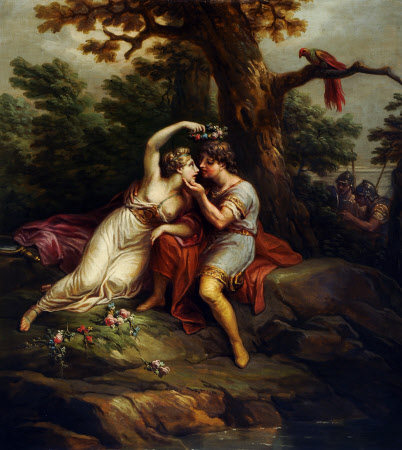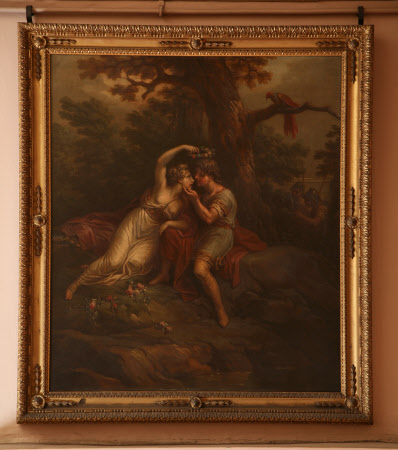Rinaldo and Armida
Antonio Zucchi, RA (Venice 1726 - Rome 1796)
Category
Art / Oil paintings
Date
1773
Materials
Oil on canvas
Measurements
1010 x 860 mm
Place of origin
England
Order this imageCollection
Nostell Priory, West Yorkshire
NT 960077.2
Summary
Oil painting on canvas, Rinaldo and Armida, previously called Angelica and Medoro: Angelica crowning Medoro with a Garland of Flowers, by Antonio Zucchi, RA (Venice 1726 – Rome 1796), 1773. A classical scene from Tasso, II Canto 17 – 20, with lovers under a tree and two soldiers behind them, the reflective mirror has been caste aside. In the background are the two Danish Knights, who are about to persuade Rinaldo to quit Armida. One of a set of six over-door paintings by Antonio Zucchi, previously, erroneously, attributed to Angelica Kauffman. A scene from Torquato Tasso's epic poem, Gerusalemme liberata (1581) and inspired by Ariosto's Orlando Furioso. The sorceress Armida has been sent to stop the Christians and is about to murder the First Crusade soldier, Rinaldo, but instead she falls in love. She creates an enchanted garden where she holds him a lovesick prisoner. Eventually two of his fellow Crusaders find him and hold a shield to his face, so he can see his image and remember who he is.
Provenance
Commissioned from Antonio Zucchi by Sir Rowland Winn, 5th Bt (1739-1785); sent to Nostell Priory circa 1773; thence by descent; accepted in lieu of tax by HM Treasury and transferred to the National Trust in 1986.
Credit line
Nostell Priory, The St Oswald Collection (National Trust)
Marks and inscriptions
Top right of support: Chalk inscription at top right area reads “SITTING ROOM 8” Lower central stretcher bar: Paper label reads: '“Nostell Priory:No 30, Artist: Angelica Kauffmann, Subject: Angelica & Medoro (VI)”
Makers and roles
Antonio Zucchi, RA (Venice 1726 - Rome 1796), artist Thomas Chippendale (Otley 1718 - London 1779) , framemaker
References
Sands 2011: Frances Sands, 'The Art of Collaboration: Antonio Zucchi at Nostell Priory', The Georgian Group Journal, vol.XIX, 2011, pp.106-119

